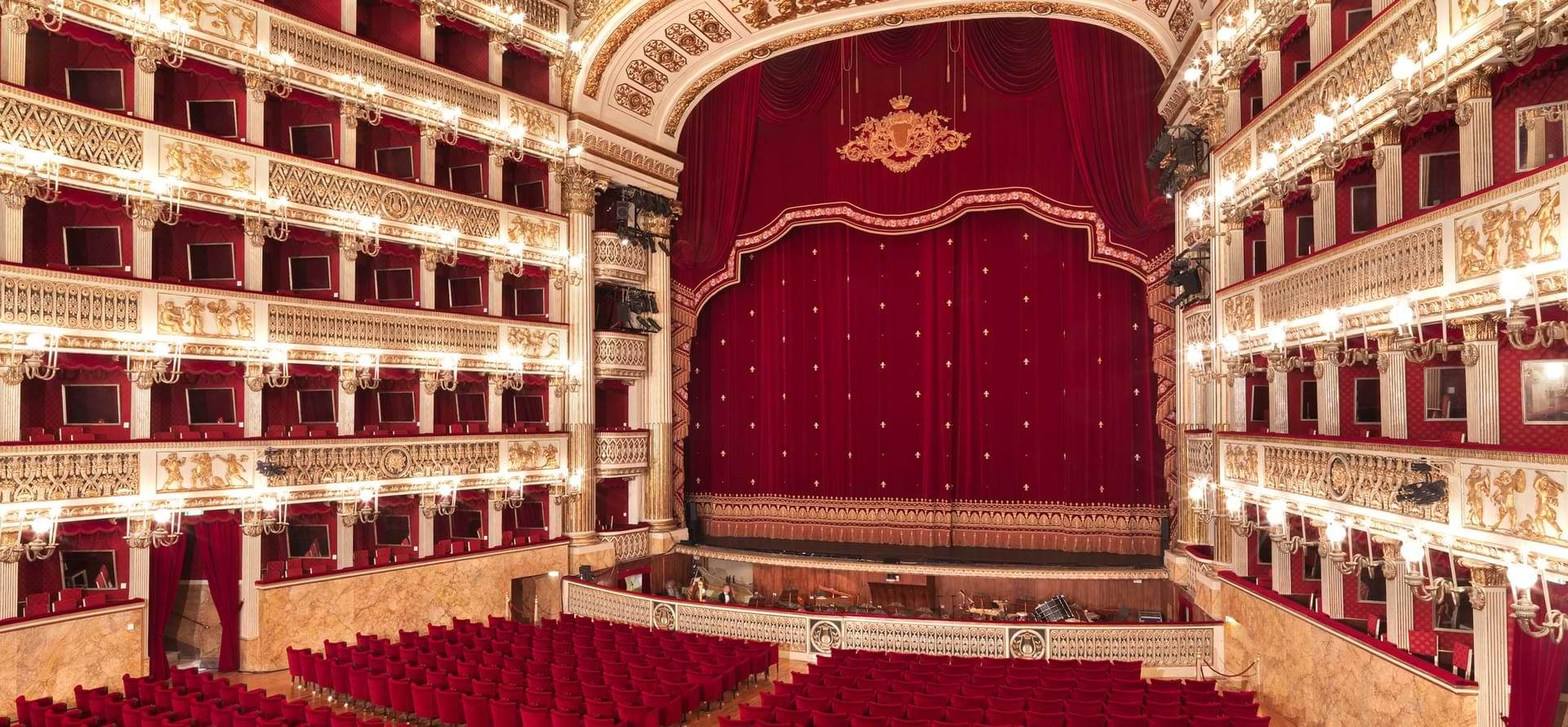Mithridates, King of Pontus
Mo | Tu | We | Th | Fr | Sa | Su |
Opera seria in three acts
Libretto by Vittorio Amedeo Cigna-Santi
Music by Wolfgang Amadeus Mozart
Synopsis
Place: around the Crimean port of Nymphæum
Time: 63BC during the conflict between Rome and Pontus
Prologue
Mitridate, having suffered a heavy defeat in battle, is presumed dead. This incorrect news is passed by Arbate, the Governor, to Aspasia (Mitridate's fiancée) and to Farnace and Sifare (Mitridate's sons).
Act 1
Scene 1
Arbate, the governor of Nymphæum, welcomes Sifare. We learn that Sifare resents his brother, Farnace, because of his brother’s strong ties with their enemies, the Romans. Arbate pledges his loyalty to Sifare. Aspasia pleads for Sifare to help her against advances by Farnace. He accepts her plea and reveals his love for her.
Scene 2
Farnace makes his advances to Aspasia. She refuses, supported by Sifare, who protects her from his forceful brother. News arrives that Mitridate is alive and is approaching the city. Arbate urges the brothers to conceal their differences and greet their father. The brothers agree to hide their feelings for Aspasia. Farnace conspires with Marzio, Roman legionary officer, against Mitridate.
Scene 3
Mitridate arrives on the shores of Nymphæum with Princess Ismene, daughter of his ally the King of Parthia. Mitridate wants Farnace to marry Ismene, his promised bride. Ismene is in love with Farnace but senses problems and is worried about her future. Arbate tells Mitridate that Farnace is pursuing Aspasia, not mentioning Sifare. The jealous Mitridate swears revenge on Farnace.
Act 2
Scene 1
Farnace scorns and threatens Ismene. She tells Mitridate, who suggests that she should marry Sifare. Mitridate asks Aspasia for immediate marriage but she hesitates, proving to him that she is unfaithful. Aspasia confesses love to Sifare but they both agree to part to save their honour. Sifare plans to leave and Aspasia is troubled by the conflict between love and duty.
Scene 2
Mitridate is aware of Farnace's plot against him with the Romans; he plans his revenge, despite Marzio’s offer of peace, and arrests Farnace to execute him. Ismene rescues the prince, who admits his treachery but implicates Sifare. Mitridate tricks Aspasia into admitting her love for Sifare and swears revenge. Aspasia and Sifare wish to die together, in fear of Mitridate’s threats.
Act 3
Scene 1
Ismene, still in love with Farnace, tries to convince Mitridate to forgive Aspasia. The Romans attack and Mitridate leaves for battle. Aspasia contemplates suicide by poison. Sifare also wants to die, and joins his father in the battle.
Scene 2
Marzio liberates Farnace and promises him the rule of Nymphæum. Farnace changes his mind, deciding to side with Mitridate.
Scene 3
Defeated, Mitridate commits suicide, avoiding captivity. Before he dies he gives his blessing to Sifare and Aspasia and forgives Farnace, who now agrees to marry Ismene. All four pledge to free the world from Rome.
Program and cast
Opera in Italian with surtitles in Italian and English.
Duration: approximately 4 hours and 30 minutes, with interval.
Conductor | Riccardo Frizza,
Director | Claus Guth,
Sets | Christian Schmidt,
Costumes | Ursula Kudrna,
Lighting | Olaf Winter,
Choreography | Sommer Ulrickson
Cast:
Mitridate | Giovanni Sala
Aspasia | Sara Blanch
Sifare | Mariangela Sicilia
Farnace | Franco Fagioli
Ismene | Giuliana Gianfaldoni
Marzio | Alasdair Kent
Arbate | Agustín Pennino
Orchestra and Ballet of the Teatro di San Carlo
Ballet Director | Clotilde Vayer
Produced by Teatro di San Carlo in co-production with Teatro Real Madrid, Oper Frankfurt and Grand Teatre del Liceu
First performance at the Teatro di San Carlo
Teatro San Carlo Naples Italy
Teatro di San Carlo Napoli; San Carlo Opera House; Real Teatro di San Carlo Naples.
The Real Teatro di San Carlo (Royal Theatre of Saint Charles), its original name under the Bourbon monarchy but known today as simply the Teatro di San Carlo, is anopera house in Naples, Italy. It is located adjacent to the central Piazza del Plebiscito, and connected to the Royal Palace.
It is one of the oldest continuously active venue for public opera in the world, opening in 1737, only five years after the Manoel Theatre in Malta and decades before both the Milan's La Scala and Venice's La Fenice theatres.
The opera season runs from late January to May, with the ballet season taking place from April to early June. The house once had a seating capacity of 3,285.but nowadays has been reduced to 1414 seats.[3] Given its size, structure and antiquity was the model for the following theatres in Europe.
History of the opera house
Commissioned by the Bourbon King Charles VII of Naples (Carlo VII in Italian), Charles wanted to endow Naples with a new and larger theatre to replace the old, dilapidated, and too-small Teatro San Bartolomeo of 1621, which had served the city well, especially after Scarlatti had moved there in 1682 and had begun to create an important opera centre which existed well into the 1700s.
Thus, the San Carlo was inaugurated on 4 November 1737, the king's name day, with the performance of the opera Domenico Sarro's Achille in Sciro, which was based on the 1736 libretto by Metastasio which had been set to music that year by Antonio Caldara. As was customary, the role of Achilles was played by a woman, Vittoria Tesi, called "Moretta"; the opera also featured soprano Anna Peruzzi, called "the Parrucchierina" and tenor Angelo Amorevoli. Sarro also conducted the orchestra in two ballets as intermezzi, created by Gaetano Grossatesta, with scenes designed by Pietro Righini. The first seasons highlighted the royal preference for dance numbers, and featured among the performers famous castrati.
In the late 18th century, Christoph Willibald Gluck was called to Naples by the impresario Tufarelli to direct his 1852 Clemenza di Tito at the theatre, and Johann Christian Bach in 1761-62 brought two operas, Catone in Utica and Alessandro nell'Indie.
1737: Construction of the Teatro di San Carlo
The new opera house was designed by Giovanni Antonio Medrano, a military architect, and Angelo Carasale, the former director of the San Bartolomeo. The horseshoe-shaped auditorium is the oldest in the world. It was built at a cost of 75,000 ducats. The hall was 28.6 meters long and 22.5 meters wide, with 184 boxes, including those of proscenium, arranged in six orders, plus a royal box capable of accommodating ten people, for a total of 1,379 seats. Including standing room, the theatre could hold over 3,000 people. The fastidious composer and violinist Louis Spohr reviewed the size and acoustic properties of this opera house very thoroughly on 15 February 1817 and concluded that:
there is no better place for ballet and pantomime. Military movements of infantry and cavalry, battles, and storms at sea can be represented here without falling into the ludicrous. But for opera, itself, the house is too large. Although the singers, Signora Isabella Colbran, [Prima Donna of the Teatro San Carlo opera company and Rossini's future wife], and the Signori Nozzari, Benedetti, etc., have very strong voices, only their highest and most stentorian tones could be heard. Any kind of tender utterance was lost.
Much admired for its architecture, its gold decorations, and the sumptuous blue upholstery (blue and gold being the official colours of the Bourbons), the San Carlo was now the biggest opera house in the world.[6] In relation to the power of the existing Bourbon Kingdom of the Two Sicilies, Beauvert notes that the design of the house, with its 184 boxes lacking any curtains was so that "no one could avoid the scrutiny by the sovereign" who had his private access from the Royal Palace.
In 1809 Domenico Barbaia was appointed manager of the royal opera houses in Naples and remained in charge until 1841. He soon established a reputation for innovative and dazzling productions, which attracted both the public and leading singers to the opera house.

 EN
EN DE
DE IT
IT FR
FR ES
ES RU
RU JP
JP RO
RO
 Seating plan
Seating plan